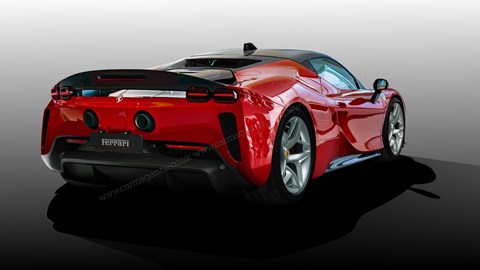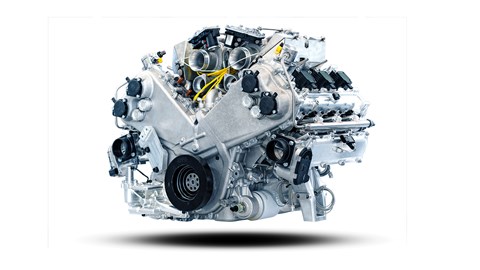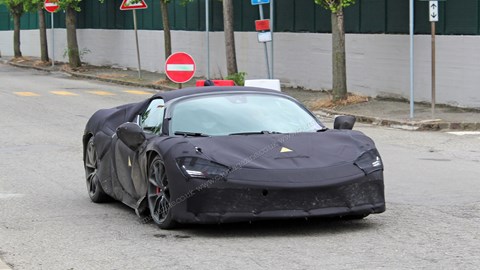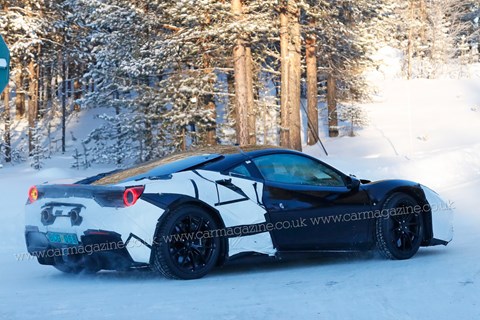► New Ferrari hybrid supercar, codename F171
► All-new twin-turbo V6 with hybrid power
► Due in late 2021, price likely to top £200k
In late 2019 Ferrari vowed that 60% of its cars would be hybrid by 2022. Given that deadline is now months, not years, away, it follows that 2021 will be the year it embraces electrification like a proud father hugging his newly graduated son. Right now, Ferrari has just one hybrid.
Two new models will, in the coming months, shift its powertrain portfolio in the electric direction – a new mid-engined supercar known internally as the F171, and the Purosangue ‘SUV’ (Ferrari hates the label, and there’s plenty of evidence the car will be more Audi A6 Allroad than Q7 in philosophy). Happily, these cars also align perfectly with Maranello management’s strategic goal of profitable growth. The Purosangue and the F171 ‘Dino’ could together boost combined sales north of 15,000 units a year.
But what is the F171? Ferrari’s saying nothing, but the clues are myriad. It will use a hybrid powertrain, the internal combustion engine element of which will be a new twin-turbo 3.0-litre V6. Ferrari confirmed back in 2019 that a V6 was in development, and that it would see action – in different states of tune – in both future front-engined cars (like the Purosangue) and mid-engined supercars (like the F171).
‘For the future we are developing the V6 engine, which has benefits in terms of duty exemption [3.0 litres is a key threshold in some important global markets] and also electrification,’ said Enrico Galliera, Ferrari’s chief marketing and commercial officer. ‘This will give us a new approach and price positioning, and allow us to create a larger family.’
The fastest hybrid cars revealed

Making sense of that family is key to understanding where the F171 (our rendering above) fits. The Dino name has been denied time and again, not least by recently departed CEO Louis Camilleri, so we don’t expect the new V6 to resurrect that badge. The V8 engine will live on, in front-engined cars like the Roma and, with hybrid boosting, in the big-ticket, near-1000bhp stuff like the SF90. A 750bhp hybrid F8 with the e-motor on the front axle may yet also join the fray.
But, capable of making north of 700bhp without e-motor assistance, the V8 has out-grown the role of powering Maranello’s entry-level, mid-engined supercar. Ferrari’s also long quashed Dino theories with the argument that coming down in price is a hiding to nothing, doing little more than hoovering up precious manufacturing capacity while offering a slimmer profit margin in return – not an attractive combination. Maranello is rigorous in the work it puts into maintaining margin (its cars are thought to be considerably more profitable than Aston Martin’s, for example) and keeping the F171 close to the F8’s £200k (just as McLaren repositions its sub-720S Artura to a higher price point, up from £150k to nearer £200k) will do a lot of good work to this end.
CAR understands this previously unseen engine is a 120° 3.0-litre V6 with twin turbos, and that in the F171 it will be hooked up to a hybrid pack for part-time boosting, torque fill and anti-lag duties. Unlike the SF90, the front axle won’t be powered, initially at least, and the car will carry a single e-motor, mounted inline with the crank but the other side of the clutch for a limited (figure on 15-20 miles) electric-only range.

The 120° V6 has a number of advantages in a hybrid powertrain – just ask Aston; its new V6 (above, which may or may not see the light of day – Aston’s new management must decide) also uses a 120° vee angle (see right). With fewer cylinders, a V6 is lighter, shorter and more efficient than a V8: handy given electrification brings extra weight, and adding the e-motor to the driveline tends to increase wheelbase, despite the best efforts of Ferrari’s slim ‘pizza’ axial-flow motor.
The big vee angle lowers the centre of gravity and, together with the catalysts and exhaust plumbing, helps create an easy-to-accommodate, vaguely cuboid package. What’s more, if you go for a ‘hot-in-vee’ configuration (turbos and exhausts on top of the engine, between the cylinder heads; intake systems on the outside – the opposite of Ferrari’s V8 arrangement), as Aston Martin has, the 120° angle gives plenty of space for big turbochargers. Useful when you’re trying not be an anti-climax after a long line of big-capacity V8s…
Numbers? Expect a system output of some 700bhp, with around 110bhp from the e-motor boosting the V6’s 590-ish bhp. But as important to chief technology officer Michael Leiters will be raising the hairs on the back of your neck. He’s long been a passionate advocate of hybridisation, seeing the instant response and strong torque of e-motors as the perfect foil for powerful but potentially laggy and torque-shy turbocharged engines with high specific outputs.

CAR magazine’s spies have already spotted hybrid supercar mules testing around the Maranello HQ in Italy, as well as on cold-weather manoeuvres in Scandinavia.
‘The near-future is definitely about electrification; not pure electrification but hybridisation. There is the potential for even more performance,’ Leiters has told CAR previously. ‘On the other hand, it adds weight. We must compensate for the weight and also have better driving emotions. With pure electric, I am convinced that for Ferrari we need more time. The most important reason for our customers to buy a Ferrari is the sound…’
True enough, to see the heavily disguised V6 development cars caught testing in video footage is to be treated to the weird spectacle of a mid-engined Ferrari belting around a test track, only to then cut its engine and proceed on silent e-power… Weird but undoubtedly the way Ferrari must go, to both futureproof its cars in a fast-changing regulatory environment and to meet the very real customer demand for a low-profile, very quiet e-drive mode for slipping off your driveway and out of town.
And the rest of the car? The tub will not be carbon. Instead, the F171 will use the multi-material, aluminium-intensive architecture that’ll underpin all future Ferrari models bar a couple of limited-run cars. The lightweight chassis, which will likely be shorter between the wheels than the F8, will help offset the weight of the hybrid system, as will the smaller, lighter V6 engine.
And ensuring the V6 is every bit as good to drive as the V8s it effectively replaces will be a next-generation suite of driver-assist electronics, a field in which Maranello has established itself as a master. Slide control, intuitive but rapid steering, beautifully integrated electric and petrol power – the F171 will deploy them all to ensure Ferrari’s mid-engined crown doesn’t slip.

Leiters again, talking to CAR in Ferrari’s 70th anniversary year: ‘What makes a Ferrari a Ferrari is the interaction between car and driver; the loop of inputs and outputs that you feel when you drive that makes you feel involved in the process. You get a good feeling for the car. You try new inputs and you get confidence back. So, you try more, and more, and more. In the end the car is like an extension of your body – you feel the car around you. You get information from the steering and pedals, obviously, but also from vibration, from sound – it all links together so that, in a short time, you can understand the physics of this game. And at the end of the drive you go home, you close the garage and you feel emotion from this driving experience. It’s not just the data sheet – this is not enough. It is much more than this.’
Amen. Rest assured Ferrari’s hybrid future is in very safe hands.
Check out our Ferrari reviews